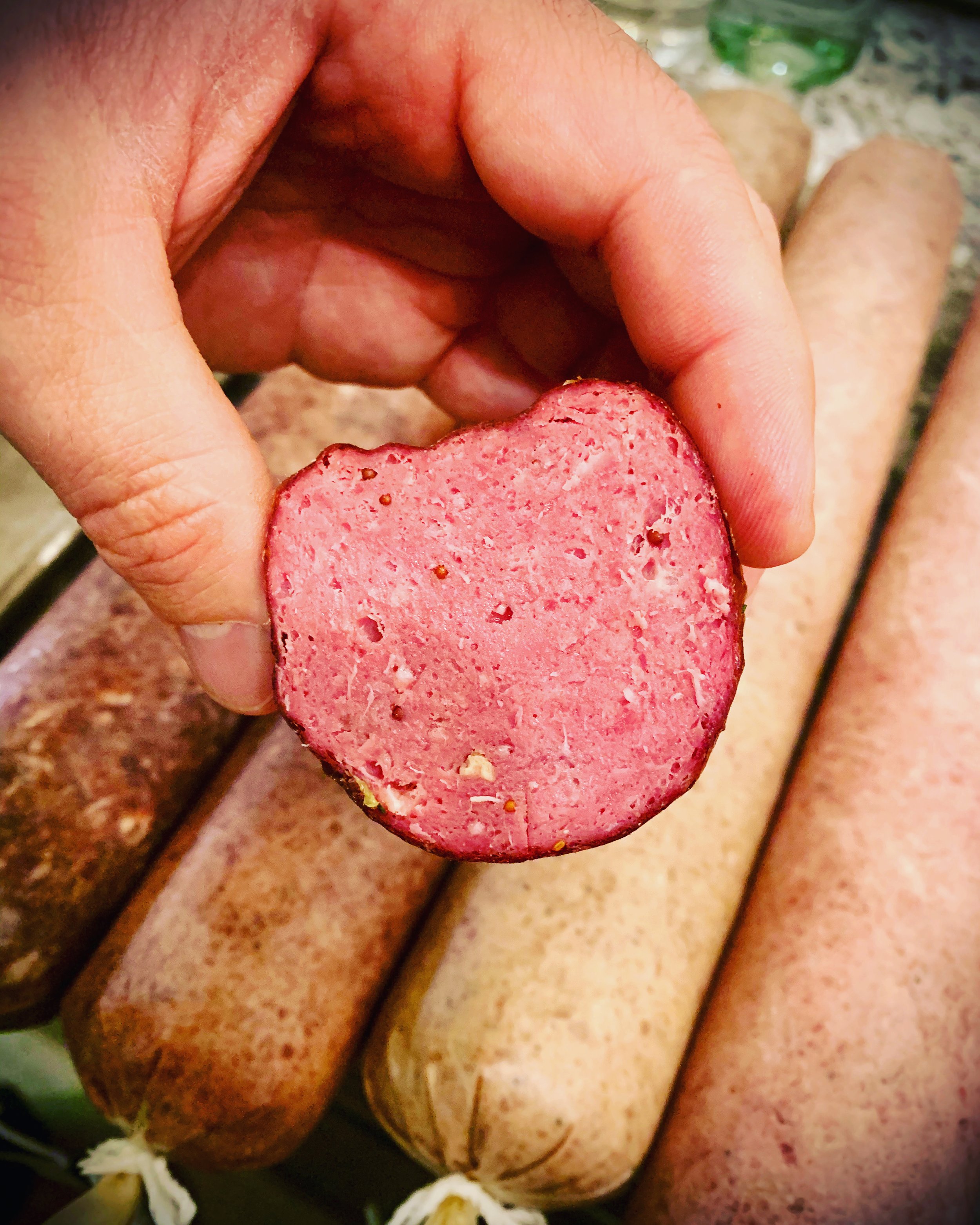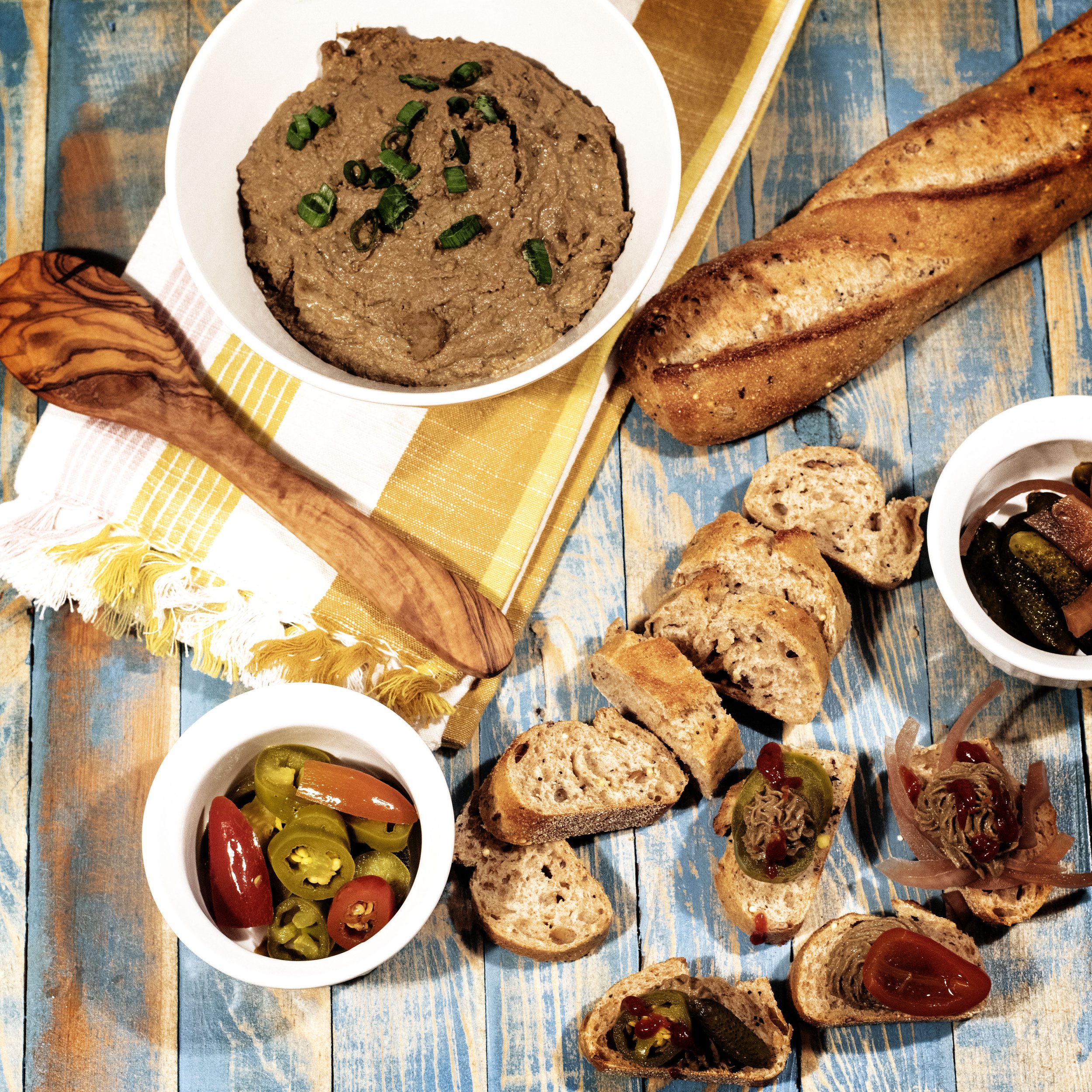My favorite boating snack is definitely summer sausage, Ritz cracker, and a slice of cheddar cheese. It’s actually my favorite hiking snack. And fishing snack. And hunting snack. And sitting on the porch at the end of the day snack. And bored at home snack. It’s just the best snack. It’s even better when it’s made from your own harvested wild game too! And it’s even better than that when you add home grown Carolina Reaper peppers for Reaper Elk Summer Sausage.
I started making my own summer sausage about a year ago. Store bought is okay. Getting it from a butcher is better than store bought. Having a butcher that processes wild game make you some from your own meat is even better than that. But the best is absolutely making it yourself. You get to control the salt level, the cuts of meat that go into it, the fat content, and the spices.
I feared the summer sausage process to begin. It seemed daunting. I also had a really difficult time finding a solid recipe online. And smoke times and temperatures? Almost impossible to find. I got incredibly lucky that a person on Instagram reached out to me and shared smoke times and temperatures.
So, after a few practice runs and some recipe perfecting, I am ready to share my Reaper Elk Summer Sausage recipe.
Homemade summer sausage is pretty easy to pull off, but there are a few tricks that make it turn out fantastic instead of just good. First tip: keep your meat and fat very cold! This is one of the most important steps for making summer sausage. If things get to warm while you are working the fat will separate and ruin the texture of your final product. So, between each step of mixing and grinding I stick the meat into the fridge for about thirty minutes.
Okay, let’s start making some Reaper Elk Summer Sausage. Following the first tip of summer sausage making, start with cold meat and cold fat. This recipe will make four summer sausage sticks that are two and a half pounds each. I do a ratio of 20% fat to 80% meat. So, for this recipe you need eight pounds of wild game meat of your choosing and 2 pounds of fat.
For the fat, most people prefer pork fat. I have never had the opportunity to work with pork fat as it seems nearly impossible to acquire. I have asked the local supermarkets and butcher, and all that is ever available is beef fat. So, I have only used beef fat, but it works great in my opinion.
For this recipe, I used elk for the meat. I have also done deer, bear, and pronghorn. They all turned out amazing. So, use whatever is in your freezer and you won’t be disappointed.
Run your meat and fat through a grinder using a coarse plate first. I used an 8mm grind plate. I also have a very inexpensive meat grinder. I love it. It didn’t break the bank, doesn’t take up much space, and is convenient enough to use I can just pull it off the shelf and grind up fresh burger meat at a moment’s notice. The grinder I am currently using, and have for quite a few years, is just this one: Cabelas Deluxe Meat Grinder.
Give the meat a quick mix to get the fat and meat incorporated. It is also time to add the spices now! I love the spice mixture for this Reaper Elk Summer Sausage. It obviously is spicy. The Carolina Reapers add a slow building heat to sausage that definitely lights your mouth up for a bit, but if you like a little kick you will thoroughly enjoy the reapers.
The allspice and cloves add a little sweetness and a slight touch of bitter, which pairs wonderfully with the heat from the Carolina Reapers. Pair that heat, sweet, and touch of bitter with the tang from the fermenting agent for summer sausage and you have one tasty snack on your hands.
Continuing on, to your meat and fat mixture add six tablespoons of kosher salt, 4 tablespoons of dextrose, and two teaspoons of pink salt #1. The pink salt extends the shelf life of cured meats, gives everything that pretty red hue, and assists in the prevention of spoilage from bacteria. Dextrose is added to cured meats to feed the lactic acid organisms that create that wonderfully tangy fermented flavor.
Once you have your salts and dextrose mixed in add your seasoning agents: 1 tablespoon of dry yellow mustard, 3 teaspoons of garlic powder, two teaspoons of ground ginger, 2 teaspoons of coriander, one tablespoon of allspice, and two teaspoons of ground cloves.
Next add your mustard seeds. Most people put in about two tablespoons. I eyeball it because I love the texture the seeds add to the summer sausage. I do more like three tablespoons. I also add more freshly cracked black pepper for the same reason. You don’t want to completely over-do it with the pepper because it can change the flavor of the summer sausage, but I do more like a tablespoon while others recommend less.
Finally, it’s time to add your heat! The Carolina Reapers I used for this recipe were from my home garden. I dried them in a window for two months and then ground them into a powder. This recipe used three dried Carolina Reapers, which worked out to one pepper per 3.33 pounds of meat. This is equated to a teaspoon of powder for the entire recipe. I would recommend some gloves at this point.
This recipe is for lovers of the heat! You can adjust the level of heat to fit your personal preference. To drop the heat level, you could add less of the Carolina reapers or use a different type of pepper, such as a habanero, serrano, or jalapeno. If you aren’t a fan of heat at all you can omit the pepper completely.
Get everything mixed really well. If you use your hands, I suggest wearing gloves because of the peppers.
Alright, time for the final steps before we place our meat back in the fridge: the fermenter. There are lots of different types of fermenting agents available. One of the more popular ones is Fermento. I used pediococcus culture. I ordered it online. It is a little spendy, but you can make pounds and pounds of summer sausage from one bag.
There are lots of different options for pediococcus culture. All of them provide protection against listeria and such; however, they all produce different results as far as the sourness of your finished product. There are some that will make your summer sausage very sour and tangy, and others that are much less so. I used a one that created a little less sour flavor since I was adding so many other spices to this summer sausage.
The pediococcus culture needs to be kept in the freezer to survive. You also shouldn’t handle it with bare hands. For ten pounds of summer sausage, I mixed ¾ cup of water with 3 teaspoons of dextrose. I then mixed in 3/8 a teaspoon of the pediococcus culture. Stir until the dextrose is dissolved and then pour over your meat mixture. Mix everything together.
Now that the spices have been added and the fermenting agent, place the meat mixture back in the fridge for thirty minutes to cool the meat back down.
After the meat has cooled, run the entire batch through the grinder a second time on a smaller grind plate. I used a 4.5mm plate. Place the meat back in the fridge to cool once again. I let it sit another thirty minutes even though the meat hadn’t warmed up too much this time. I wanted everything to be nice and cool for packaging the summer sausage.
Switch the grinding plate out for the stuffing accessories. You also need to let your summer sausage casing soak for ten minutes in the sink. This recipe makes basically logs of summer sausage and I then cut them down into smaller blocks before vacuum packing, but the actual casings are quite large. I used the 2 and ½ by 18-inch collagen casings.
It’s time to stuff casings, which leads us to our second tip: pack the casing very tight. Like as tight as you possibly can! The tighter the better.
Once all the summer sausage is packaged, place the logs in the fridge to relax overnight. I didn’t want overly sour summer sausage, so I let mine sit for one evening. If you like sourer flavor, let them sit for two nights before smoking.
So, once you have let the summer sausage ferment and do its thing, it’s time to smoke! Finally!
Preheat the smoker to 135 to 145 Fahrenheit and add your wood of choice. I have a pellet smoker and used applewood to smoke the summer sausage. The third tip for summer sausage success is to use a meat thermometer throughout the smoking process. You want to know the internal temperature of your sausage, so you know when you increase the heat of the smoker and when to pull the meat.
This is a cool temperature smoke for a pellet smoker. I ended up placing tin foil on the rack to direct all the smoke directly at the temperature control probe and then added a rack about an inch off of the tinfoil to create an insulating air layer to prevent the heat from the fire box directly going at the sausage. I then used the probes to monitor the air temperature at each end of the sausage. This ended up working perfect as the control probe is at the opposite end of the stack, so it ended up blowing the smoke across the sausage lengthwise. I know this is confusing. If you need help, email me and I can walk you through it. This was also done in the winter. I do not know that a pellet grill would work in the summer.
Keep the smoker at 140 degrees Fahrenheit for about an hour. This is essentially the “drying” stage of summer sausage. The meat temperature should not raise a lot during this stage of cooking. Keep at this until the internal sausage temp is 80 to 85 degrees.
After about an hour, kick the heat up to 160 degrees Fahrenheit. This is when you will start to get a lot more of the smoke saturation. I let the sausage smoke at 160 degrees for about an hour. The internal temperature should be 140 at the end of this cycle.
Finally, kick the heat up to 180 degrees Fahrenheit and finish cooking the summer sausage. This is where watching the internal temperature is most important. Pull the sausages from the cooker once the internal temperature reaches 154 degrees. This step can take a few hours, anywhere from two to three. A lot of factors affect the cooking time, such as how tightly packed the casing are, the type of meat used, moisture content of the meat, and I’m sure so many other things we don’t even realize. That is why it is important to pull the summer sausage by internal temperature and not cooking time.
Alright, time for the final tip! Immediately upon removing the summer sausage from the smoker, plunge the sausages into cold water. This will help set the meat, resulting in a much better final texture, and makes removing the casings easier.
You don’t have to keep the sausages in the water long, a few minutes is good enough. Before packaging the sausage for storage, let them cool completely, which takes about an hour. To store, I cut them into chunks that I would use for taking on a hike or serving at a party, which is about six-inch-long pieces. I then vacuum package the chunks for freezing. I started vacuum packing the sausage because the first time I made them I just loosely wrapped them in plastic wrap and stuck them in the freezer and they freezer burned after a month. I didn’t take into consideration that the casings are permeable, which I felt I should have thought about because I knew the sausage absorbed smoke so well during the cooking process. Anyway, they freezer burned, which I hate, so I started vacuum packing them after that experience.
Anyway, that is my recipe and process for creating this Reaper Elk Summer Sausage.
Happy Hunting!





















